Walking (Part I)
-Gary Player
I’ve been preparing to write about walking ever since I began these pages seven years ago. The reason I've waited so long to tackle it is because it's so important. In a sense, walking is tango. Or at least the physical expression of it. If you can walk well in the compás, you’ve got it. The rest is just decoration. Once you learn to walk well to the music, you'll have the balance and control to do almost anything. Picking up new steps or patterns becomes merely window-shopping. All you need to do is decide which ones you want—like deciding what kind of dress you like, or what color of tie you want to wear. You can try on different steps, use them a little, and then keep them or throw them back.
Different people learn in different ways. My approach for something complex is to break it down and try to understand each element. This doesn’t work for everything. The mysteries of tango in general are too profound for that approach—but the specific physical activity of walking in the compás isn't. So let’s review some of the basic exercises of tango walking, and then we'll take our first step. We'll see if we can unlearn the kind of walking we’ve been doing since we were babies, and become tango dancers:
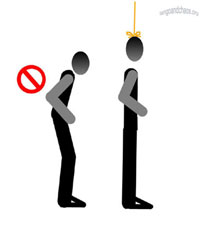
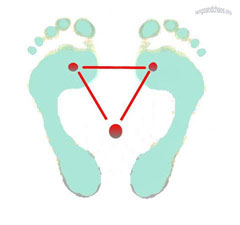
Start with tall, "string" posture, and know your tango Balance Points.
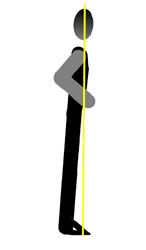
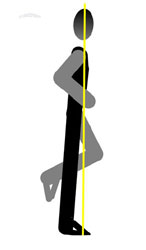
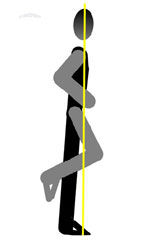
Be comfortable on your two Front Balance Points, and then learn to
put all your weight on one Balance Point, and raise the other foot.
A Small Step Forward
Okay, lets take a step: Go back to your Zero Balance point. Find it, stay very relaxed and centered, and then pick up one foot. Hold it a few inches off the floor with your foot hanging relaxed, and your toe down. You now have all of your weight centered over one foot. We're halfway there, but we need to add one more thing. Imagine as you stand perfectly balanced with one foot held up and relaxed, that someone gives you a little shove right between your shoulder blades (you might even get someone to do it). You'll begin to tip forward... and what you do next is important:
1. Do not bend your supporting leg.
2. Do not lose your posture.
3. Don't try to take a big step. 12 inches is plenty.
As you begin to tip, simply raise your knee slightly, and swing your foot forward to catch yourself… and try to straighten your leg exactly at the moment that your foot contacts the floor. Straightening early is bad, and late is also bad (there are names in Argentina for these bad habits, and we'll discuss them later). If you do it just right, the front balance point on the bottom of your foot should contact the floor right when your leg straightens:
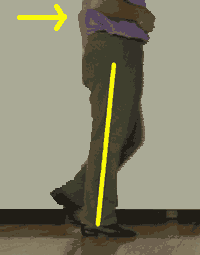


Our first tango step: In Picture 1 we are balanced tall and straight over our Front Right balance point.
An unseen force (arrow) gives us a shove, and we begin to tip forward and raise our knee a little...



...and as we tip further, we begin to straighten our knee. Our leg reaches full extension exactly when
our foot contacts the floor (last picture). Notice the yellow line: My right leg never bends.
A couple of things to note. First, look at the yellow line in all of these video captures. My right leg does not bend. There are certain times when you bend your legs when walking in tango, but this isn't one of them. Don't do it. Think about keeping your supporting leg straight and tall as you tip forward. Second, notice that when my left leg contacts the floor, it's not bent either. If you look closely at the video and at the last two pictures, you can see that it straightens at the exact point where my foot contacts the floor.
Another thing to think about is the center of my weight. Look at the first three pictures (top row) where the step begins. Notice how far forward I tip before I really "begin the step"... that is, before I begin to bring my free leg forward. This is very important, because it's what gives tango walking it's surging forward look, and it also gives a strong, clear chest lead to your partner. If you learn it, your walking will look dynamic, and it will have a dynamic, smooth feel that your partner will like. And most importantly, this step creates one of the basic elements of musical expression (which we'll discuss soon). For now, remember that bringing your leg out too soon is one of the bad habits of tango.
In the last picture above, we have just landed on the floor on a straight leg. What happens next? The goal is to ride that leg right back up to our Zero Point—the neutral point of balance that we return to after every step. Here's how it should look:



Keep your leg perfectly straight, and ride it right up to your Zero point.
Throughout this whole series my weighted leg remains perfectly straight. From a high balanced point with feet together, I ride it down as I fall forward. Then I ride the other leg back up to my balance point. We'll discuss this more on the next page, but first let's look at one more thing:
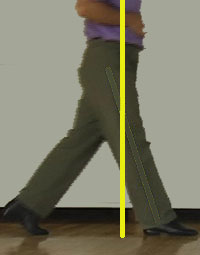

Your weight should be forward as soon as your foot contacts the floor.
The vertical yellow line represents the center of my balance. My right foot has just contacted the floor, and my body is already forward so that my full weight moves onto it very quickly. You can see the weight leaving my left foot in the first frame, and in the second frame my trailing left foot has left the floor, and the weight is all on my right leg. This is called "stepping into the floor", and you should be able to spot it in the video. It gives the walking a solid look. Not moving your weight quickly over your step is the result of improper technique, and it leads to all kinds of problems.
All of the three elements we have discussed, stepping from one straight leg onto another, tipping forward into the step with your upper body, and moving your weight quickly onto the leg that contacts the floor are very important in tango. Not doing them creates a bad habit with a bad name. In Argentina they call these bad habits: "Walking on your knees", "testing the water", and "walking on eggs". We'll demo them later.
Take a look at the video again, and see if you can spot the things we've been discussing:
So the surprising conclusion is that there is no reason to bend your supporting leg while walking forward in tango! A lot of people have trouble understanding this, and when I try to explain it, the response is sometimes patronizing. It often ranges from, "Oh, yeah... whatever..." to, "Well I suppose... if you want to walk like a robot." It's discouraging to try to explain something important about tango to people who make money teaching it, and have them look at you like you just said you were abducted by aliens on a flying saucer.
But there's also the other side. After I posted the video this morning, a guy came by the house to do some work. I had the laptop out, and since no one other than Alej had seen the clip, I decided to show it to him. All I said was that it's something from the Internet, and I wondered what he thought. He wasn't in tango. He was a man who repairs bathrooms, but he looked at it a couple of times—a few seconds of video, with no soundtrack, showing a man taking three steps in street clothes. He thought for a moment, and said, "Lindo. Es tango, no?" Nice! At least somebody gets it.